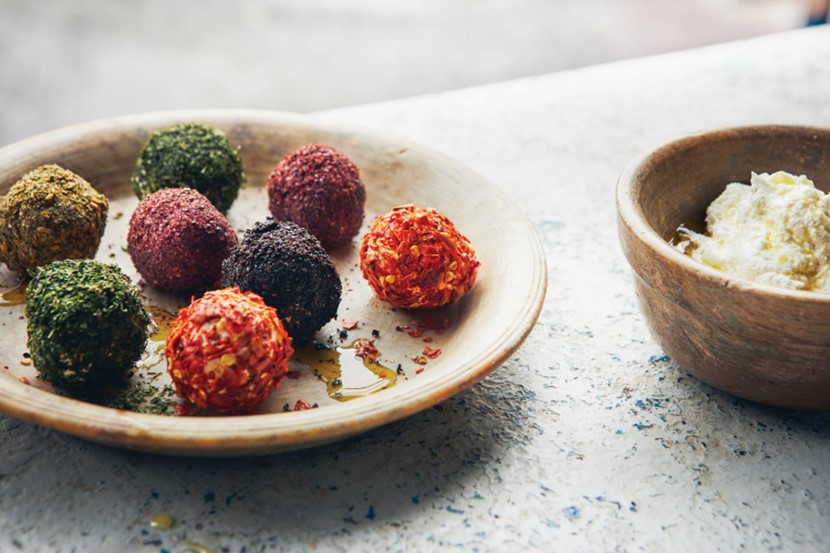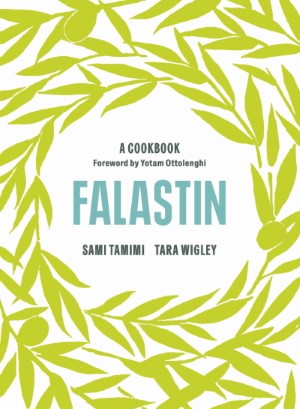Labneh Balls

Play around with coatings and combinations here: a clash of colours and flavours works really well as part of a larger mezzeh spread. We’ve given instructions for a combination of chilli flakes and za’atar, but all sorts of coatings work, for example Nigella seeds, sesame seeds, other chilli flakes (smoky Urfa or sweet Aleppo look great), sumac, chopped pistachios, or a combination of crushed garlic, chopped walnuts and finely diced red chilli. Play around with the size of the balls as well. Large balls work well as a snack or as part of a mezzeh spread; smaller balls work well for nibbles with drinks.
Makes about 20 balls, to serve ten as part of a larger spread
900g Greek-style yoghurt (or a combination of 450g goat’s yoghurt and 450g Greek-style yoghurt)
About 500ml olive oil
3 sprigs of thyme or oregano, or a mixture of both
1 ½ tbsp chilli flakes (enough to coat 10 balls)
2 ½ tbsp za’atar (enough to coat 10 balls)
Salt
To make labneh
1. Line a deep bowl with a piece of cheesecloth or muslin (a clean J-cloth is also fine as an alternative) and set aside.
2. In a separate bowl, mix the yoghurt(s) with 1 teaspoon of salt. Pour into the cloth-lined bowl, then bring the edges of the cloth together and wrap tightly to form a bundle. Tie firmly with a piece of string. Hang the bundle over a bowl (or attached to the handle of a tall jug so that the bundle can hang free inside the jug) and leave in the fridge for up to 24 - 36 hours, until much of the liquid is lost and the yoghurt is thick and fairly dry.
3. Another method is to put the bundle into a sieve placed over a bowl, with the weight of a plate, for example, or a couple of tins, sitting on top: this weight speeds up the draining process.
4. Transfer the labneh to an airtight sterilised container or jar. Pour over just enough olive oil so that the labneh is covered and sealed.
To make the labneh balls
5. With lightly oiled hands, spoon a small amount – about 20g – of the labneh into the palm of one hand. Roll it around to shape it into a 3cm-wide ball, and transfer it to a tray lined with a damp (but clean) J-cloth. Continue with the remaining labneh until all the balls are rolled. Transfer to the fridge for a couple of hours (or overnight) to firm up.
6. Half fill a jar or airtight container (large enough to fit all the rolled labneh, about 10cm wide and 12cm high) with olive oil and drop in the balls. Top with more oil, if necessary – you want the balls to be completely covered with oil – and add the thyme or oregano. Seal the jar and store in the fridge.
7. When ready to coat – you can do this up to a day before serving – remove the jar from the fridge and bring to room temperature, so that the oil becomes unset. Lift the balls out of the oil and roll them in the chilli flakes or za’atar. An easy way to do this is to spread your chosen coating on a plate, place a few balls at a time on top and shake the plate; the balls will be coated in seconds. If not eating at once, return them to the fridge on a plate (but not in the oil). Bring back to room temperature before serving so they’re not fridge-cold.
Keeping notes: The balls keep for up to two months in the fridge. The oil will set in the fridge, so you'll have to bring it back to room temperature before being able to remove the balls and coat them. Save the oil, it can be used again to preserve future batches of labneh.

FALASTIN is a love letter to Palestine, the land and its people; an evocative collection of over 110 unforgettable recipes and stories from the co-authors of Jerusalem, Ottolenghi: The Cookbook and Ottolenghi SIMPLE.
Recipe extracts: FALASTIN, RRP$60 from selected bookstores nationwide.

AS FEATURED IN ISSUE 49 OF OHbaby! MAGAZINE. CHECK OUT OTHER ARTICLES IN THIS ISSUE BELOW

















